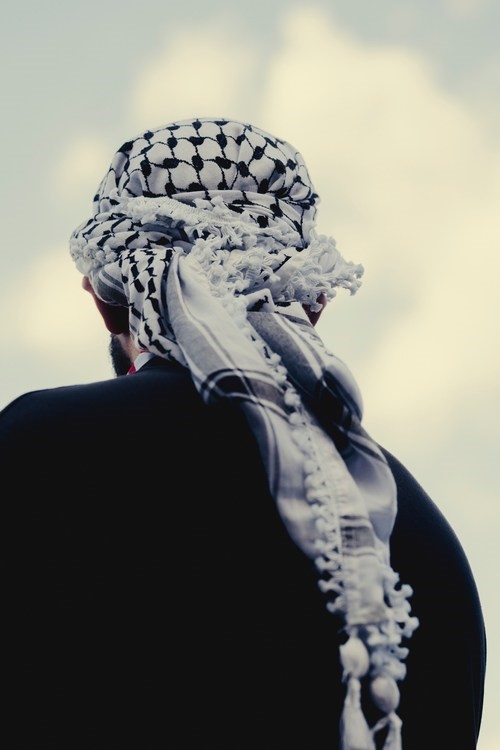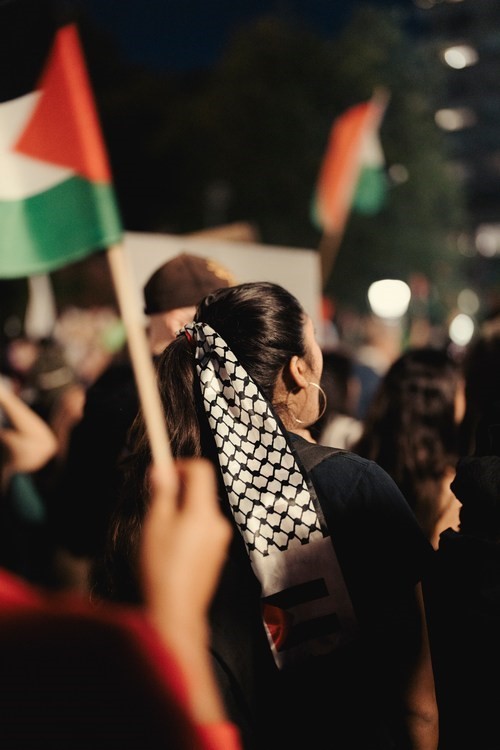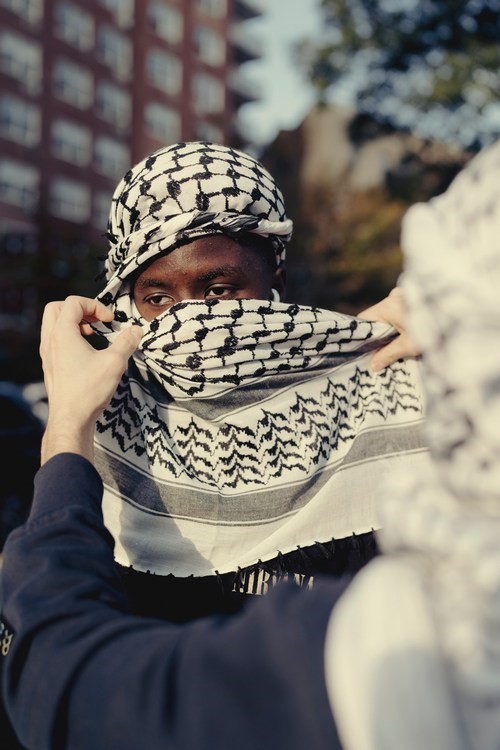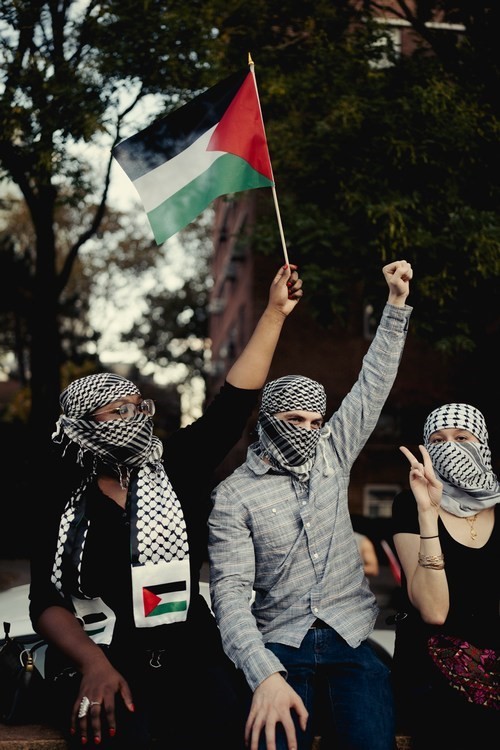Around the neck, over the head, draped down the back, pinned
into hair, wrapped around a face — there are many ways to style a kaffiyeh, the
square checkered scarf traditionally worn in parts of the Middle East.
اضافة اعلان
The black-and-white version in particular has become a badge of
Palestinian identity, with many Palestinians wearing it at events such as
weddings and graduations. The kaffiyeh has also been adopted by Palestinians as
a symbol of their aspiration and long struggle for independence, making it
divisive to those who associate it with the fighting involved in that struggle.

As demonstrations have cropped up globally in support of
Palestinian civilians in the Gaza Strip, some Palestinians have been
encouraging non-Palestinians to embrace the kaffiyeh as a symbol of unity, and
to wear it as a show of solidarity.
At a march for Gaza in New York on October 26, kaffiyehs were
worn by a diverse group carrying Palestinian flags. Three men, who were
sandwiched between two halal carts, prayed on top of a kaffiyeh in lieu of a
prayer mat.
Binh Ly, 33, who had a black-and-white kaffiyeh around his neck,
said he hadn’t been sure if he could wear the scarf until he talked about it with
a Palestinian friend. “She gave me permission,” said Ly, who is Vietnamese and
lives in Queens. His parents, he added, fled to the United States because of
the Vietnam War.
Ivanna Rodriguez-Rojas, a 24-year-old who lives in Manhattan,
had a black-and-white kaffiyeh around her head at the protest. She said she
also didn’t know that Palestinian people encouraged non-Palestinian people to
wear the scarf until she saw a recent post on X, formerly known as Twitter,
shared by Fatima Saleh, a 38-year-old Palestinian who lives in Edmonton,
Alberta.

“Yes anyone can wear it! Your solidarity means everything to
us,” the post read.
Saleh said in an interview with The New York Times that she has
given kaffiyehs to some of her friends who have been vocal about their support
for Palestinians, and that she knows other Palestinians who have also done so.
“It’s probably one of the most personal gifts a Palestinian can
give someone,” she said.
While her post on X was meant to encourage wearing kaffiyehs as
a show of solidarity, she said, there is a fine line between appreciation and
cultural appropriation.
As examples of appropriation, she cited fast fashion brands that
have sold versions, like the styles sold by Urban Outfitters and Zara in the
2000s, when kaffiyehs were worn by some as a fashion statement. (That trend had
emerged in parts of Europe as early as late 1970s.)
“Wearing an authentic kaffiyeh to show solidarity with
Palestinians and our struggle — I think that’s a beautiful gesture,” Saleh
said.
Ted Swedenburg, an emeritus professor of anthropology at the
University of Arkansas, who has studied the kaffiyeh for 40 years, said the
scarf has been used by rural and nomadic Palestinians as protection from
sunburn, dust and sand. He said it became linked to Palestinian nationalism
during the Arab revolt against British rule from 1936 to 1939.

In the 1960s, the kaffiyeh became further associated with the
Palestinian national movement because its longtime leader, Yasser Arafat, who
died in 2004, almost always wore the scarf, Swedenburg said. In 2006, Hamas
took a majority of seats in the Palestinian legislative elections, ending 40
years of political dominance in Gaza by Arafat’s rival party.
Swedenburg said that from 1967 to 1993, when Israel essentially
banned flying the Palestinian flag in Gaza and the West Bank, many Palestinians
waved the kaffiyeh instead. During the first intifada, the Palestinian uprising
against Israel’s occupation of the West Bank and Gaza that took place from 1987
to 1993, images of young people wearing kaffiyehs and throwing rocks at Israeli
soldiers played on television news.

The kaffiyeh’s appearance in armed conflicts and violent clashes
between Palestinians and Israeli forces has made the scarf a polarizing
garment. Last month, Germany banned pro-Palestinian demonstrations and schools
in Berlin were permitted to ban kaffiyehs. The city’s education senator,
Katharina Guenther-Wuensch, wrote in a letter to schools that it and other
actions represent “a threat to school peace in the current situation.”
Swedenburg said that associating the kaffiyeh with extremism
misrepresents it. He described it as an “expression of support for the right of
people to live.”
Lately, Swedenburg added, he has also noticed more kaffiyehs
being worn by non-Palestinian people, as well as a rise in kaffiyeh-patterned
clothing.
Hirbawi, a Palestinian-owned manufacturer in the West Bank that
has been producing kaffiyehs since 1961, has recently seen a level of demand
that its brand manager, Nael Alqassis, said “is unparalleled in our history.”
Alqassis, 41, said that the company sold more than 18,000 kaffiyehs in October.

At Hirbawi the scarves are made using traditional
cross-stitching techniques, he said. The war, he added, has complicated an
already challenging shipping process: Because there is no functioning postal
service in the West Bank, kaffiyehs Hirbawi sells online are typically brought
to a warehouse in Bethlehem, then to an Israeli airport, and then to a
warehouse in Germany, where they are sent to customers around the world.
Stijn Ismail Ledegen, a 27-year-old lawyer from Flanders,
Belgium, said he recently wore a kaffiyeh he bought 15 years ago to a protest
in Brussels. To him, he said, “it’s a symbol of human rights.”
“That’s why fashion is so important,” Ledegen added. “Because
even if freedom of speech is limited, fashion can still show your statements.”
Read more Region and World
Jordan News




